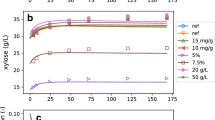Abstract
For many lignocellulosic substrates, hemicellulose is biphasic upon dilute-acid hydrolysis, which led to a modified percolation process employing simulated two-stage reverse-flow. This process has been proven to attain substantially higher sugar yields and concentrations over the conventional single-stage percolation process. The dilute-acid pretreatment of biomass solubilizes the hemicellulose fraction in the solid biomass, leaving less solid biomass in the reactor and reducing the bed. Therefore, a bed-shrinking mathematic kinetic model was developed to describe the two-stage reverse-flow reactor operated for hydrolyzing biphasic substrates, including hemicellulose, in corn cob/stover mixture (CCSM). The simulation indicates that the shrinking-bed operation increases the sugar yield by about 5%, compared to the nonshrinking bed operation in which 1 reactor volume of liquid passes through the reactor (i.e.,t = 1.0). A simulated optimal run further reveals that the fast portion of hemicellulose is almost completely hydrolyzed in the first stage, and the slow portion of hemicellulose is hydrolyzed in the second stage. Under optimal conditions, the bed shrank 27% (a near-maximum value), and a sugar yield over 95% was attained.
Similar content being viewed by others
Abbreviations
- C0 :
-
initial xylan concentration in percolation, %
- H:
-
concentration of hemicellulose as xylose in the reactor
- koi :
-
frequency factor for ki
- kj:
-
rate constant = Amkoiexp (Ei/RT), min-1. A is acid concentration.
- L:
-
reactor length, cm
- t:
-
time, min
- u:
-
velocity inside percolation reactor, cm/min
- V:
-
reactor volume
- Y:
-
yield
- βi:
-
dimensionless reaction rate, kiL/u
- γ:
-
ratio of solubilized lignin to solubilized hemicellulose
- η:
-
composition of hemicellulose in solid biomass
- θ:
-
conversion of hemicellulose during hydrolysis
- ξ:
-
shrinking factor, the ratio of the reactor volume after a compression operation to that of before the compression operation
- τ:
-
dimensionless residence time, tu/L
- ρ:
-
biomass density, g/mL
- 0:
-
value at t = 0
- ns:
-
nonshrinking-bed operation
- overall:
-
overall value based on initial condition
- s:
-
shrinking-bed operation
- 1:
-
ith operation
- j:
-
jth operation
References
Lee, Y. Y., Lin, C. M., Johnson, T., and Chambers, R. P. (1978),Biotechnol. Bioeng. Symp. 8, 75–88.
Limbaugh, M. L. (1980), MS Thesis, Auburn University, AL.
Cahela, D. R., Lee, Y. Y., and Chambers, R. P. (1983),Biotechnol. Bioeng. 25, 3–17.
Kim, B. J., Lee, Y. Y., and Torget, R. W. (1993),Appl. Biotechnol. Bioeng. 39, 119–129.
Chen, R., Lee, Y. Y., and Torget, R. W. (1996),Appl. Biotechnol. Bioeng. 57/58, 133–146.
Torget, R. W., Hayward, T. K., Hatzis, C, and Philippidis, G. P. (1996),Appl. Biotechnol. Bioeng. 57/58, 119–129.
Torget, R. W., Hayward, T. K., and Elander, R. (1997),Nineteenth Symposium on Biotechnology for Fuels and Chemicals, paper No. 4 Colorado Springs, CO.
Chen, R. (1997), PhD Dissertation, Auburn University, AL.
Author information
Authors and Affiliations
Rights and permissions
About this article
Cite this article
Chen, R., Wu, Z. & Lee, Y.Y. Shrinking-bed model for percolation process applied to dilute-acid pretreatment/hydrolysis of cellulosic biomass. Appl Biochem Biotechnol 70, 37–49 (1998). https://doi.org/10.1007/BF02920122
Issue Date:
DOI: https://doi.org/10.1007/BF02920122




